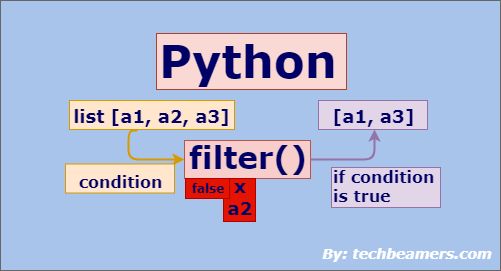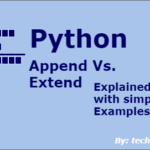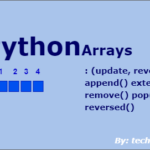The filter() method is a built-in function in Python. It is a very efficient way to filter out elements from an iterable based on a certain condition. In this tutorial, you’ll learn how to use the filter() function with different types of sequences. Also, you can refer to the examples to increase your understanding further.
Python Filter() Method
In Python, the filter() method is a built-in higher-order function that takes two arguments. The first argument is the name of a user-defined function, and the second is iterable like a list, string, set, tuple, etc. It calls the given function for every element of the iterable, just like in a loop. It has the following syntax:
# Python filter() syntax filter(in_function|None, iterable) |__filter object
- The first parameter is a function that has a condition to filter the input. It returns True on success or False otherwise. However, if you provide a None, then it removes all items except those evaluated to True.
- The next parameter is iterable, i.e., a sequence of elements to test against a condition. Each function call carries one item from the seq for testing.
- The return value is a filter object a sequence having elements that passed the function check.
Are you also looking for a technique to transform your data (e.g., a list, tuple, etc.)? If yes, check out the Python map() function.
Filter() Function Examples
Here are some examples to explain how to use the filter() function.
Filtering odd numbers from the list
In this example, we have an iterable list of numeric values out of which some are even, and few are odd.
# list of numbers numbers = [1, 2, 4, 5, 7, 8, 10, 11]
Now, here is a function that filters out the odd number from the given list. We’ll be passing it as the first argument to the filter() call.
# function that filters odd numbers
def filterOddNum(in_num):
if(in_num % 2) == 0:
return True
else:
return FalseLet’s now join the bricks and see the full working code:
"""
Desc:
Python program to filter odd numbers from the list
using filter() function
"""
# list of numbers
numbers = [1, 2, 4, 5, 7, 8, 10, 11]
# function that filters vowels
def filterOddNum(in_num):
if(in_num % 2) == 0:
return True
else:
return False
# Demonstrating filter() to remove odd numbers
out_filter = filter(filterOddNum, numbers)
print("Type of filter object: ", type(out_filter))
print("Filtered seq. is as follows: ", list(out_filter))A couple of points to notice in the example are:
- The filter() function is returning out_filter, and we used type() to check its data type.
- We called the list() constructor to convert the filter object to a Python list.
After running the example, you should see the following outcome:
Type of filter object: <class 'filter'> Filtered seq. is as follows: [2, 4, 8, 10]
It printed only the even numbers filtering out the odd ones.
Filtering duplicates from two lists
We can use the filter() function to get the difference between two sequences. For this, we’ve to filter out duplicate items.
So, let’s assume the following two lists of strings.
# List of strings having similar items list1 = ["Python", "CSharp", "Java", "Go"] list2 = ["Python", "Scala", "JavaScript", "Go", "PHP", "CSharp"]
You can check that the given lists have common entries for some of the programming languages. So, we need to write a function that checks for duplicate names.
# function that filters duplicate string
def filterDuplicate(string_to_check):
if(string_to_check in ll):
return False
else:
return TrueLet’s now get all the bits and pieces together.
"""
Desc:
Python program to find the diff. between two lists
using filter() function
"""
# List of strings having similar items
list1 = ["Python", "CSharp", "Java", "Go"]
list2 = ["Python", "Scala", "JavaScript", "Go", "PHP", "CSharp"]
# function that filters duplicate string
def filterDuplicate(string_to_check):
if(string_to_check in ll):
return False
else:
return True
# Demonstrating filter() to remove duplicate strings
ll = list2
out_filter = list(filter(filterDuplicate, list1))
ll = list1
out_filter += list(filter(filterDuplicate, list2))
print("Filtered seq. is as follows: ", out_filter)After executing the example, it produces the following result:
Filtered seq. is as follows: ['Java', 'Scala', 'JavaScript', 'PHP']
As desired, our code printed the difference between the two given lists. However, it was merely an illustration for learning how the Python filter() function works.
If you use multiple lists in your program, then this is how you can get the difference between two lists in Python.
Using lambda to filter stop words from a string
Python lambda expression also works as an inline function. Hence, we can specify it instead of a function argument in the filter() call. In this way, we can get away from writing a dedicated function for the filtering purpose.
In this example, we are going to remove stop words from a given string. We’ve mentioned them in the below list.
list_of_stop_words = ["in", "of", "a", "and"]
Below is the string that contains the stop words.
string_to_process = "A citizen of New York city fought and won in the election."
Now, we’ll see the complete code to filter stop words.
"""
Desc:
Python program to remove stop words from string
using filter() function
"""
# List of stop words
list_of_stop_words = ["in", "of", "a", "and"]
# String containing stop words
string_to_process = "a citizen of New York city fought and won in the election."
# Lambda expression that filters stop words
split_str = string_to_process.split()
filtered_str = ' '.join((filter(lambda s: s not in list_of_stop_words, split_str)))
print("Filtered seq. is as follows: ", filtered_str)Since we had to remove a whole word, so we split the string into words. After that, we filtered the stop words and joined the rest using Python join(). You should get the following outcome after execution:
Filtered seq. is as follows: citizen New York city fought won the election.
By the way, you can read more in-depth info on Python lambda here.
Lambda to filter common elements from arrays
In this example, we’ll create a lambda expression and apply the filter() function to find the common elements in two arrays. Below is the input data for our test.
# Defining two arrays having some common elements arr1 = ['p','y','t','h','o','n',' ','3','.','0'] arr2 = ['p','y','d','e','v',' ','2','.','0']
Let’s create the lambda expression that will filter the difference and return common elements.
# Lambda expression using filter() to find common values out = list(filter(lambda it: it in arr1, arr2))
Now, we’ll see the full implementation:
"""
Desc:
Python program to find common items in two arrays
using lambda and filter() function
"""
# Defining two arrays having some common elements
arr1 = ['p','y','t','h','o','n',' ','3','.','0']
arr2 = ['p','y','d','e','v',' ','2','.','0']
def interSection(arr1, arr2): # find identical elements
# Lambda expression using filter() to find common values
out = list(filter(lambda it: it in arr1, arr2))
return out
# Main program
if __name__ == "__main__":
out = interSection(arr1, arr2)
print("Filtered seq. is as follows: ", out)You should get the following outcome after execution:
Filtered seq. is as follows: ['p', 'y', ' ', '.', '0']
Using Python filter() without a function
Yes, you can call filter() without passing an actual function as the first argument. Instead, you can specify it as None.
When None is specified in the filter(), then it pops out all elements that evaluate to False. Let’s consider the following list for illustration:
# List of values that could be True or False bools = ['bool', 0, None, True, False, 1-1, 2%2]
Here is the full code to analyze the behavior of filter() with None as the function argument.
"""
Desc:
Calling filter() function without a function
"""
# List of values that could True or False
bools = ['bool', 0, None, True, False, 1, 1-1, 2%2]
# Pass None instead of a function in filter()
out = filter(None, bools)
# Print the result
for iter in out:
print(iter)The following is the result after execution:
bool True 1
We hope that after wrapping up this tutorial, you should feel comfortable using the Python filter() function. However, you may practice more with examples to gain confidence.
Also, to learn Python from scratch to depth, do read our step-by-step Python tutorial.









